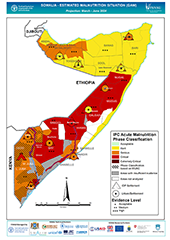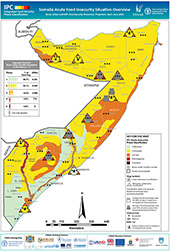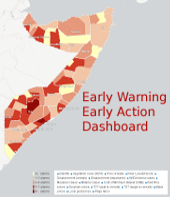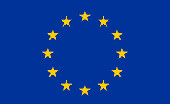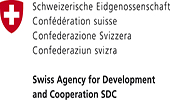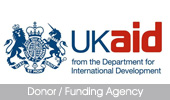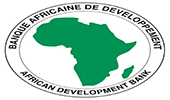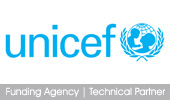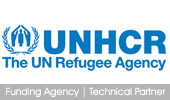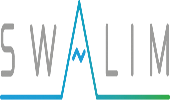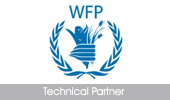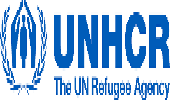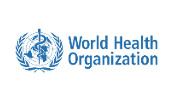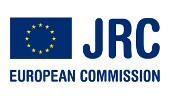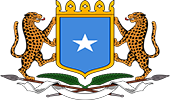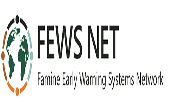Up to 2.7 million people in Somalia face acute food insecurity Crisis (IPC Phase 3) or worse outcomes through mid-2021
Issued: February 4, 2021
Approximately 839 000 children likely to be acutely malnourished
February 4, 2021, Mogadishu/Washington – Up to 2.7 million people across Somalia are expected to face food consumption gaps or depletion of livelihood assets indicative of Crisis (IPC Phase 3)[1] or worse outcomes through mid-2021 in the absence of humanitarian assistance. The drivers of acute food insecurity in Somalia include the compounding effects of poor and erratic rainfall distribution, flooding, Desert Locust infestation, socioeconomic impacts of COVID-19, and conflict. Moreover, approximately 840 000 children under the age of five are likely to be acutely malnourished, including nearly 143 000 who are likely to be severely malnourished. It is likely that sustained, large-scale humanitarian food assistance and government support since July 2020 have mitigated the magnitude and severity of food insecurity. Through at least mid-2021, Desert Locust will continue to pose a serious risk of damage to both pasture and crops across Somalia. Available forecasts indicate an increased likelihood of below-average rainfall during the 2021 Gu (April-June) season across most of the country, which would adversely affect food security and nutrition outcomes. These findings are based on the 2020 post-Deyr seasonal food security and nutrition assessment conducted across Somalia in November and December 2020. The assessment and the subsequent analyses were jointly led by the Food Security and Nutrition Analysis Unit (FSNAU, a project managed by the Food and Agriculture Organization of the United Nations) and the Famine Early Warning Systems Network (FEWS NET, a project funded by USAID) with the active participation of government institutions, UN, and NGO partners.
Delayed and erratic rainfall distribution characterized the October to December 2020 Deyr season, resulting in below-average, cumulative rainfall across most of the country. The poor rains led to inadequate replenishment of pasture and water resources and below-average Deyr crop production. In addition, Cyclone Gati caused significant damages and livestock deaths in northeastern coastal areas in late November, though the rains ultimately alleviated dry conditions. Furthermore, recurrent floods between July and early November caused further population displacement and damaged crops and farmland in riverine areas of Hiiraan, Shabelle, and Juba regions. Despite favorable Hagaa/Karan (July-September) rainfall in agropastoral and pastoral livelihood zones in the Northwest, the rains could not compensate for crop losses caused by poor Gu (April-June 2020) rainfall during the planting, germination, and growing season.
2020 Deyr season cereal production in southern Somalia is estimated at 78 600 tons, which is 20 percent below the 1995-2019 average. The main factors for below-average production include: poor and erratic rainfall, recurrent flooding, Desert Locust, and conflict. In the Northwest, 2020 Gu/Karan cereal production harvested in November 2020 is estimated at 17 100 tons, which is 58 percent below the 2010-2019 average, mainly due to poor and erratic rainfall and Desert Locust and stalk borer infestations on both sorghum and maize.
Rural populations are experiencing multiple declines in food and income sources. In pastoral areas, below-average rainfall in parts of the North, adjacent areas of central Somalia, coastal areas, and Gedo region has led to water scarcity and pasture shortages, prompting atypical, earlier-than-normal livestock migration to distant grazing areas. As a result, milk availability for consumption and sale is limited. Additionally, a sharp decline in livestock exports since August 2020 has adversely affected pastoralists and other households who work in the livestock value chain. In many pastoral livelihood zones, poor households with limited saleable animals will face moderate to large food consumption gaps through mid-2021. In agropastoral livelihood zones, where the main shocks include erratic and poorly distributed rainfall, Desert Locust and stalk borer infestations, and conflict, poor households have experienced crop losses and low income from agricultural employment. With few alternative food and income sources, they face moderate to large food consumption gaps through mid-2021. In riverine livelihood zones along the Shabelle and Juba rivers, recurrent floods destroyed farmland and crops and displaced local populations, leading to significant crop losses and the loss of income from agricultural employment. Consequently, a significant proportion of poor households in riverine areas will also face moderate to large food consumption gaps through mid-2021.
The impacts of the erratic 2020 Deyr season rainfall on rural livelihood activities have also negatively affected food security among Internally Displaced Persons (IDPs) in rural areas. Furthermore, a majority of IDPs in urban areas are poor with limited livelihood assets, few income-earning opportunities, and high reliance on external humanitarian assistance. As a result, a significant proportion of IDPs (both rural and urban) face moderate to large food consumption gaps through mid-2021. Some of the urban poor across Somalia also continue to face moderate to large food consumption gaps over the same period, partly due to the continued decline in external remittances and a slowdown in economic activities in urban areas related to the impacts of the COVID-19 pandemic.
Based on the results of household surveys and field assessments conducted in November and December 2020, approximately 1.6 million people face Crisis (IPC Phase 3) or worse outcomes in the presence of planned and likely humanitarian assistance during the January-March 2021 period. An additional 2.5 million people are Stressed (IPC Phase 2), bringing the total number of people experiencing acute food insecurity to 4.1 million. Levels of humanitarian assistance for food security and nutrition, as well as government support, are expected to continue at levels similar to late 2020 during the January-March 2021 period. From July to December 2020, assistance reached more than 1.8 million people per month on average, which likely prevented more severe food security and nutrition outcomes across many parts of Somalia.
From April to June 2021, food insecurity is expected to deteriorate among poor rural, urban, and displaced populations due to the impacts of anticipated, below-average 2021 Gu (April-June) season rainfall, the high risk of continued Desert Locust infestation, likely continuation of the socioeconomic impacts of COVID-19, and protracted conflict. In summary, 2.7 million people across Somalia are expected to face Crisis (IPC Phase 3) or worse outcomes between April and June 2021 without sustained humanitarian assistance. An additional 2.9 million people are expected to be Stressed (IPC Phase 2), bringing the total number of people facing acute food insecurity to 5.6 million. The April-June 2021 projections do not factor in the potential impact of food assistance, as information on planned and funded food and cash assistance through June 2021 was not available at the time of the analysis. Humanitarian assistance must be sustained through mid-2020 to prevent Crisis (IPC Phase 3) or Emergency (IPC Phase 4) outcomes for 2.7 million people. Livelihoods support is also required for people that are Stressed (IPC Phase 2) or worse.
Region | Population (2014) | Number of Acutely Food Insecure People (Rural, IDP, and Urban Combined) | |||||
Current (January-March 2021) | Projected (April-June 2021) | ||||||
Stressed (IPC 2) | Crisis (IPC 3) | Emergency (IPC 4) | Stressed (IPC 2) | Crisis (IPC 3) | Emergency (IPC 4) | ||
Awdal | 724,572 | 153,400 | 74,100 | 15,700 | 185,400 | 113,500 | 33,000 |
Woqooyi Galbeed | 1,321,525 | 275,300 | 147,600 | 13,900 | 335,500 | 218,600 | 28,000 |
Togdheer | 755,794 | 172,100 | 117,100 | 24,400 | 188,000 | 159,500 | 32,900 |
Sanaag | 562,066 | 112,500 | 110,000 | 18,100 | 140,500 | 163,200 | 53,900 |
Sool | 360,431 | 74,200 | 60,200 | 2,200 | 89,900 | 98,900 | 25,900 |
Bari | 712,934 | 152,100 | 142,700 | 13,700 | 178,200 | 206,000 | 32,000 |
Nugaal | 337,588 | 78,000 | 55,000 | 15,800 | 85,000 | 76,700 | 22,000 |
Mudug | 627,724 | 173,100 | 90,400 | 17,700 | 177,500 | 148,300 | 42,300 |
Galgaduud | 427,810 | 104,000 | 47,700 | 3,300 | 109,600 | 78,500 | 15,100 |
Hiraan | 422,993 | 77,000 | 51,500 | 0 | 87,900 | 68,500 | 8,800 |
Middle Shabelle | 436,759 | 89,200 | 52,000 | 3,000 | 99,100 | 74,500 | 7,800 |
Lower Shabelle | 911,503 | 206,000 | 77,500 | 1,300 | 225,000 | 121,800 | 6,000 |
Bakool | 284,354 | 47,600 | 25,900 | 1,500 | 57,800 | 43,600 | 6,400 |
Bay | 846,599 | 153,500 | 114,600 | 10,200 | 179,500 | 176,000 | 39,600 |
Gedo | 430,940 | 107,600 | 56,700 | 6,000 | 118,500 | 76,700 | 11,600 |
Middle Juba | 286,539 | 43,100 | 34,400 | 0 | 56,100 | 40,800 | 0 |
Lower Juba | 648,937 | 119,400 | 119,000 | 3,000 | 141,800 | 151,100 | 9,900 |
Banadir | 2,228,463 | 359,100 | 74,600 | 0 | 470,600 | 235,700 | 24,900 |
Grand Total | 12,327,531 | 2,497,200 | 1,451,000 | 149,800 | 2,925,900 | 2,251,900 | 400,100 |
According to the results of 36 separate nutrition surveys conducted by FSNAU and partners in November and December 2020, the overall median Global Acute Malnutrition (GAM) in Somalia remained Serious, indicated by weight for height z-score of 10-14.9 percent or by a mid-upper arm circumference below 125 mm of 5-9.9 percent. The drivers of acute malnutrition include high morbidity, low immunization, and vitamin-A supplementation, reduced access to milk, and food insecurity. Urgent treatment and nutrition support are required for approximately 838 800 children under the age of five years (total acute malnutrition burden), who will likely face acute malnutrition through December 2021, including 143 200 who are likely to be severely malnourished. Integrated interventions should be provided to support recovery and prevent deterioration in the nutrition situation.
Areas and Populations of Concern
Population groups classified as Crisis (IPC Phase 3) or worse require interventions aimed at reducing food consumption gaps, eradicating acute malnutrition, saving lives, and protecting and saving livelihoods. The following are considered areas of concern and are in need of urgent nutrition and health support interventions. They currently have or are projected to have a GAM prevalence of Critical, indicated by a weight-for-height z-score of 15-29.9 percent or by a mid-upper arm circumference below 125 mm of 10-14.9 percent: Shabelle Riverine, Mogadishu IDPs (Banadir), Juba Riverine, Southern Inland Pastoral (Elberde), Xudur urban/IDPs, Bay Agropastoral, Baidoa IDPs, Beletweyn, Jalalaqsi, Buloburte, and Mataban districts, Bosasso IDPs, Garowe IDPs, Galkacyo IDPs, and Hawd Pastoral (central regions).
FSNAU and FEWS NET will continue to monitor conditions and outcomes and report on the situation. All information will be made available through www.fsnau.org and www.fews.net. For more information, please contact: Alberto TrilloBarca, Communications Officer, FAO Somalia, Tel: + 252 619 154 103/+254 768 055 361, Email: Alberto.TrilloBarca@fao.org or Mike Bennett, Communications Director, Famine Early Warning Systems Network (FEWS NET), Email: fews.media@fews.net.
Click here to download the full report (English)
Click here to download the full report (Somali Version)
[1] The Integrated Food Security Phase Classification (IPC) is a set of tools and procedures to classify the severity of food insecurity using a widely accepted five-phase scale: IPC Phase 1=Minimal; Phase 2=Stressed; Phase 3=Crisis; Phase 4=Emergency; and Phase 5=Famine at the area level (Phase 5=Catastrophe at the household group level).
